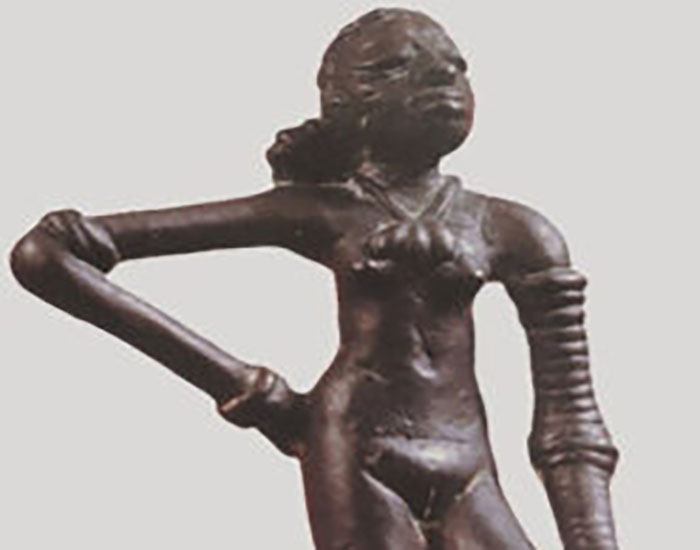
A bronze statuette depicting a free-standing nude female, the Dancing Girl was excavated from the Indus Valley Civilisation site of Mohenjo-daro (in present-day Sindh, Pakistan). Dated to c. 2500 BCE of the Mature Harappan Phase and recovered in 1926 by British archaeologist Ernest MacKay, the figure measures 10.5 centimetres in height, 5 centimetres in width and 2.5 centimetres in depth. Made using the lost-wax casting technique, this artefact is set apart from its terracotta counterparts by its representation of complete female nudity and its spare ornamentation. The Dancing Girl is so named for the assumed profession of the female figure — that of a nautch girl — and the pose she is shown holding.
The slender figure is depicted as being exaggeratedly long-limbed and nearly bare, aside from some jewellery. Leaning slightly on the right leg, the figure’s asymmetrical stance mirrors the uneven distribution of ornamentation on her body. The left arm, covered almost entirely in approximately twenty-four bangles, hangs down to just above the left knee, against which she appears to be holding a pot-like object. The right arm, ornamented with just four bangles around the elbow and wrist, is cocked at the elbow and clenched into fist (with the thumb outside), which rests on the back of the slightly-raised right hip. Both legs are bent at the knees, but the left appears to be positioned ahead of the right. Around the neck and the chest is a necklace strung with three, or possibly four, large bead-like pendants. The slightly upward-tilted face has a high forehead, large eyes, wide nose and full cheeks and lips, with long hair that is tied and bundled, resting off to the right on the nape of the neck.
As with many other Indus Valley artefacts, the identity and significance of this bronze figure is undetermined, with scholars presenting competing views. The original and dominant interpretation, by British archeologist John Marshall, that lent the artefact its name, has been challenged by more recent scholars who question its assumption (deemed inaccurate and discriminatory) of the figure’s stance as that of a dancing pose. These contemporary and alternate interpretations include that of the figure being a warrior — because of the uneven ornamentation of her hands — and a woman in a defiant stance. Some scholars even believe the Dancing Girl’s face to have Dravidian features, giving rise to various other theories about the ethnic identity of the figure depicted and the demographic makeup of the Indus Valley Civilisation.
This artefact is a telling index of the Indus Valley Civilisation’s advanced understanding of metallurgical processes and its active patronage of the arts. The Dancing Girl is now displayed in the National Museum, Delhi, as a part of its Pre-History and Archaeology collection.
First Published:
Last Updated: July 26, 2023

